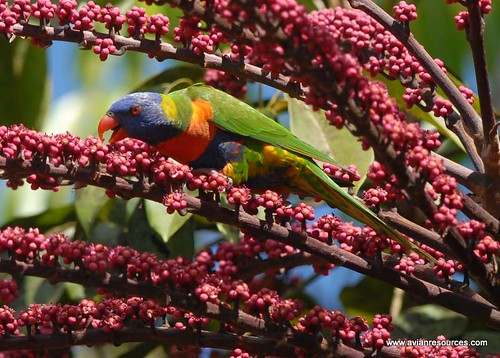tags: Swainson's Blue Mountain Rainbow Lorikeet, Trichoglossus haematodus moluccanus, identify this bird, birds, mystery bird, bird ID quiz
[Mystery bird] Swainson's Blue Mountain Rainbow Lorikeet, Trichoglossus haematodus moluccanus, photographed at Yungaburra, Queensland, Australia. [I will identify this bird for you in 48 hours]
Image: Steve Duncan, 26 August 2009 [larger view].
Nikon D200 w/ Nikkor 300mm f/4 & TC17E.
Please name at least one field mark that supports your identification.


ahh, a gorgeous bird- the Rainbow Lorikeet, Trichoglossus haematodus: violet-blue head and stomach, a bright green back, tail and vent, and an orange breast and beak...
now the problem in classification is that this "species" is considered a "species complex" with the some 20 "subspecies" considered separately therefore the bird above is T. h. moluccanus, endemic to eastern Australia and Tasmania and called Swainson's Lorikeet
Swainsons Lorikeet, or Blue Mountain Lorikeet.
This Rainbow Lorikeet subspecies is distinguished by a blue belly and a red/orange breast with no barring. Lack of a red collar distinguishes it from the more northern Red Collared species.
and it appears that it is feeding on one of the lilly pillies, the common name for a number of flowering trees in the family Myrtaceae (cloves, eucalyptus, allspice, guava, etc.) which has the greatest representation of species in the Australasia ecozone, characterised by clusters of pink/mauve berries...
I don't think that's a lillypilly, David. It looks very much like an umbrella tree (Schefflera) (fam. Araliaceae). They're fruiting here (Far North Queensland) at the moment, so the birds are having great fun.
Oh wow Snail, you are absolutely correct- Schefflera actinophylla- I've never, ever seen one in flower (and I used to tend over 300 of them in an indoor garden atrium in Washington, DC)!
Schefflera actinophylla (close-up)
Schefflera actinophylla, Malaga, Spain
I'm not familiar with Schefflera actinophylla, but that definitely isn't the "lilli-pilli". The lilli-pilli has purplish fruits about the size of grapes; they are edible and have a texture resembling styrofoam. (If it hadn't been over 20 years since I've done my biology courses I may have been able to give a more detailed description of the fruit.) Many birds love it but I don't recall any type of parrots feeding on it.